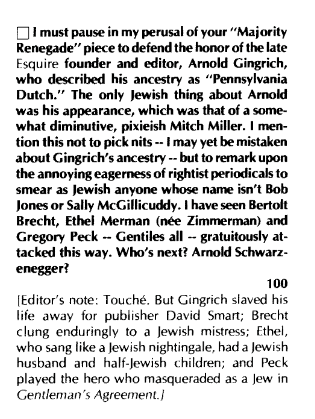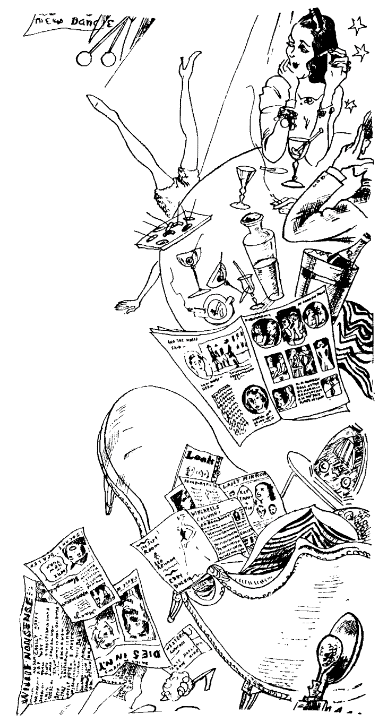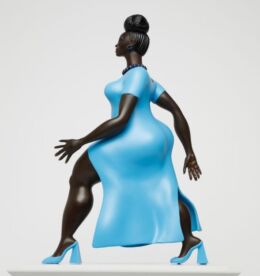Popcult Humor from Wilmot Robertson: Remembering Wilmot Robertson (April 16, 1915–July 8, 2005)
In the early 1980s I was involved with the startup of a “humor magazine” that never went anywhere after its colorful-but-vague pilot issue. Apart from a couple of National Lampoon veterans, we were mostly post-collegiate types, full of quirky, off-the-wall ideas from our own days at colorful-but-vague college humor mags. It was around this time that one of my colleagues mentioned, as a bit of curious arcana, that he had heard that somewhere out there was a racist humor magazine.
No! You don’t say! I said. Or something like that. I didn’t ask the magazine’s name, because that would have been showing untoward interest. Furthermore, the colleague in question was the same guy whose mother raised her kids to believe that if you bought Welch’s Grape Juice, you were funding the John Birch Society. Thus he was a great source of whimsical urban legends with little to back them up.
Knowing the name of the periodical was beside the point. The point was that this rumor existed, and that notion was funny in itself, because you could just imagine what sort of wild, rancid crap might be in there. It’s like today when you tell aging midwits that there are White Nationalist media outlets out there, and they go, “Oh! Stormfront?” Something they heard about 25 years ago but would never want to investigate further. They have an idea what it’s all about, and that’s good enough for them.
In this case the unnamed “racist humor magazine” was presumably Instauration, and the rumored “humor” must have referred mostly to its silly/incisive/tiresome cartoons of Willie and Marv. (Willie was a gloriously afro’d 1970s negro holding a boombox, while Marv was a snide, stoop-shouldered Jew in a cardigan.) A few years later, after my startup humor rag was long dead and buried, I ended up contributing odd cartoons and text squibs to Instauration — just to keep my hand in, you know. A little later, editor Wilmot Robertson retired the by now very dated Willie and Marv.
Beyond that, I can’t think of an awful lot of straight-up funny business going on in the pages of that beloved magazine. Overt attempts at humor were mostly snarly and leaden. For example, the snooty-bitch “society column” written by someone calling himself Cholly Knickerbocker, serving up plausible-looking newsbriefs mixed in with off-color fantasies about miscegenation, AIDS, Jewish supremacy, and other variants in degeneracy.
Or the November 1983 cover photo of Anthony Blunt, former knight, former Surveyor of the Queen’s Pictures — sweetly captioned OLD FAG ANTHONY BLUNT, Of Stalin’s Snobbish Spy Network.
Confusingly enough, two issues later our cover boy was Michael Whitney Straight “Majority Renegade of the Year.” Scion to wealth and onetime Cambridge Red, Straight’s main claim to fame — or greatest sin — was that he was the one who shopped his old friend Sir Anthony to the American and British intelligence services. (But surely that was a good thing?)
Like the quasi-Leftist critic Dwight Macdonald, Instauration had a reverence for High Culture, particularly that which was somewhat obscure. No room here for kitsch, or Macdonald’s “Masscult and Midcult.” If there was an article about sculpture, it would probably be on Praxiteles — or, better yet, Arno Breker! If Instauration had a composer on its cover, it might be Carl Orff — who, it was emphasized, stayed put in National Socialist Germany and didn’t run off to Hollywood. Or perhaps Percy Grainger, another “folkish” composer, one who specialized in writing pastiches of Morris dances and Irish reels.
This leaden stuff is why the letters pages, known as “The Safety Valve,” were such must reading, and remain so today. You got big laughs, lots of venom, and — best of all — occasional mention of things that were happening in the present-day Real World. Movies and TV, and sometimes even sportsball. Pop culture.

You can buy Charles Krafft’s An Artist of the Right here.
From what I knew of Wilmot Robertson, the ventings excerpted in “The Safety Valve” were more reflective of his personality than most of what appeared in the magazine. The fact is, people who wrote for Instauration didn’t have much to say about popular culture because they didn’t follow it or read about it. Mainly they read things like . . . well, like Instauration . . . and heavy tomes on history or philosophy. But every once in a while, a discussion of old-time showbiz or society personalities would find its way into the magazine.
One of my favorite exchanges with W. R. concerned the late, great Ethel Merman. Now, especially in her latter years — that would be anytime after about 1940 — she had a memorable look and loud, brassy personality. Because of that, and the fact that her real name was Ethel Zimmerman, a naive person could easily assume that she was Jewish. But, of course, she was not. Merman’s ancestry was Scots and German, going way back, and she was raised in a churchgoing Episcopalian household. On the other hand, Wikipedia informs me that when young she modeled her voice and persona on Sophie Tucker and Fanny Brice, amongst others, thus she was deliberately molding herself in that direction, not Doin’ What Comes Naturally. So, maybe so.
Anyway, I shot a little note off to Instauration and got back a reply — was it a letter or phone call? — from the man himself. “Madame,” W. R. said, drawing himself up to his full 6’2” height (or so I imagined), “if there is an archetypal Jewess anywhere, it is most definitely Ethel Merman.” A few weeks later a longer, less jocose reply appeared in the magazine’s “Safety Valve” letters section (June 1986).
It turns out I had actually written in to correct a columnist who’d referred to the late, great Esquire editor Arnold Gingrich as Jewish, and I tossed in Ethel Merman as another example of the same misapprehension.
So far as high-class popular-culture criticism goes, it’s hard to beat “King Cole,” a beguiling analysis of Cole Porter’s musical oeuvre that appeared in Instauration in August 1977.
“The Majority composer who never sold out.” That’s the kicker.
The author briefly alludes to Cole’s often louche and debauched private life, but he puts it in the context of the times, beginning with an expatriate life in the midst of people such as the Murphys and Fitzgeralds:
Porter was a member, at home and abroad, of various, and admittedly somewhat dissolute, “sets.” What would have made him a phenomenon in any group was his dedication to composing. Even in the early 1920s, when he affected the outward lifestyle of an expatriate playboy, he was working hard; and he had some success in Paris in 1923 with his score for a modernistic ballet — since revived — Within the Quota. (The settings and story line were provided by Gerald Murphy, who had been Porter’s friend and sponsor at Yale. A truly archetypal expatriate, Murphy was also a friend to Ernest Hemingway and F. Scott Fitzgerald, and served as a model for the hero of the latter’s 1934 novel, Tender Is the Night.) Deciding that his metier was writing songs for the musical theater — he had long been “crazy” about Gilbert and Sullivan — Porter steeled himself to deal with its minority entrepreneurs and set to work.
Minority entrepreneurs. Well, you know what that means. For most of the previous century, popular-song writing and publishing had been dominated by second-, third-, and fourth-generation Ulster Scots and Irishmen such as Dan Emmet, Stephen Collins Foster, Harrigan & Hart, Chauncey Olcott, George M. Cohan, and Walter Donaldson. But by the 1920s, Tin Pan Alley — an actual place, a block of West 28th St. — had gained quite a different cast. In that context Cole Porter’s work was inevitably unique, rather weird in fact. With his Gilbert and Sullivan influence, he tended to default to complicated patter songs and “catalog” numbers that recited an endless litany of people and places. (E.g., “Chinks do it, Japs do it, Up in Lappland little Lapps do it”; or, “You’re the top! You’re the great Houdini! You’re the top! You’re Mussolini!”)
Elsewhere in the topic of showtunes, in the November 1999 issue we get an incisive, if somewhat sour, takedown of Irving Berlin, a one-man schmaltz-and-standards machine for a half-century. Instead of laboring over unusual key shifts and Gilbert & Sullivan-style patter songs about society, Berlin kept his melodies simple and singable, usually in the pop-standard key of E-flat, which happened to be the only key Berlin himself could play. (The author here, “Wolfgang Keller,” garbles that factoid to say that Berlin composed all his songs on the black keys!) Berlin kept his lyrics firmly aimed at the cheap seats. I find this passage particularly hilarious:
His 1913 song, “Snooky-Ookums,” is an example of the sort of tripe he was churning out at the time: “She’s his jelly elly roll/ He’s her sugar ugey bowl.” Presaging the inanities of MTV-style music videos, his 1946 musical, Annie Get Your Gun, featuring noisy Jewess Ethel Merman, had virtually nothing in common with any true form of musical theater. In its original production it had no discernible story-line and was more like a series of unrelated vaudeville sketches than anything else.
(Oh look! It’s that erroneous Ethel Merman trope again!)
As to the issue of Annie Get Your Gun’s disjointed plot structure, this was because Berlin was under the gun to crank out a bunch of rollicking songs, very quickly, for a proposed Annie Oakley musical that was due to be mounted in a few months, but which so far had a very sketchy book. It seems the perpetually busy Rodgers and Hammerstein had been sought out originally to do the music and libretto, but they hadn’t the time. But they agreed to produce this spindly notion of a show, though someone else would have to write the songs.
And so they called in . . . Jerome Kern . . . finest melodist of his time . . . to do the score for Annie Get Your Gun. But then Kern dropped dead! Truly. Right there on the sidewalk! A brain hemorrhage.
What a cursed production!
Last-gasp step: They brought in Irving Berlin, who thereupon cranked out “No Business Like Show Business” and a few other standards in a couple of days, the way you or I might slap together a cheese-and-cracker board. The whole production often looked like a mistake, but with all these last-minute efforts it became a money-maker, a bountiful hit. Critics panned it for having little plot and being little more than a collocation of hummable songs . . . but it’s songs that live on and on, not drama.
Now we move on to something that was supposed to be a shocker in 1984: The Cecil Beaton Scandal of 1938. This was derived from Caroline Seebohm’s recently-published The Man Who Was Vogue: The Life and Times of Condé Nast. Irving Berlin peeps in again here, or rather his wife Ellin Mackay does, in tiny scrawled rumblings about society figures, in Beaton’s wonderfully amateurish pen-and-ink drawings.

You can buy Jonathan Bowden’s collection The Cultured Thug here.
What was scandalous about these illustrations was that they showed newspapers filled with gossipy columns about Hollywood and society “kikes,” as Beaton called them. (“Mr. R. Andrew’s Ball at the El Morocco brought out all the damned kikes in town.“) Beaton had penned in these remarks in minuscule letters, so small that one might need a magnifying glass to read them.
This February 1938 issue of Vogue was already out on the stands before someone spotted Beaton’s prank. Walter Winchell screamed about it in his own gossip column, and then the house fell down on Cecil Beaton. Condé Nast himself sadly called him in and fired him.
One of the few all-out popcult endorsements from Instauration came in 1988, a couple of years after The Bonfire of the Vanities was published. FOUR-STAR SATIRE! it was called.
It’s not top criticism, but a very favorable review of the Tom Wolfe book, and one of the few notices Instauration ever gave to contemporary bestsellers. You should read it, though maybe not if you’ve read the actual novel — because it’s impossibly naïve and silly. An accurate picture of “Zoo City,” Robertson rejoices, not having been in New York for many decades, but gleefully imagining it from his perch in Frog Hollow, North Carolina. Except that it was the city Tom Wolfe had chosen to live in, and had spent most of his life in. Surely a town with a Tom Wolfe can’t be all that bad.
For a while it seemed Tom Wolfe had written The Great American Novel. Then the movie came out, and it was supposedly a stinker, and people didn’t rave about the book anymore.
This was not Tom Wolfe’s first appearance in Instauration. He was in the very first issue in 1975 — the subject of a cover story, in fact, about his book on modern art criticism, The Painted Word. Headlined “Berg, Berg and Berg,” the article wittily summarizes the story of how Abstract Expressionism and other nonsensical art fads of the 1940s, ‘50s, and ‘60s were encouraged among painters and imposed upon the public by three critics, all Jewish, named Clement Greenberg, Harold Rosenberg, and Leo Steinberg. Almost certainly, this review was written by Wilmot Robertson himself. But, like Wolfe, Robertson leaves out the interesting but inconvenient fact that the real progenitor of this venture, the political theorist who goaded Greenberg and others to propagandize for obscurantism in modern art, was a non-Jew and non-art critic I’ve mentioned before: Dwight Macdonald. Macdonald wasn’t being destructive or mischievous; he’d just come to regard most representational art as old-hat, “Masscult” stuff, stuff that pandered to the public. Too much Grant Wood, Norman Rockwell, Thomas Hart Benton. Macdonald wanted High Art, and that to him meant basically inaccessible. But that’s another story for another time.
See also the following about Wilmot Robertson at Counter-Currents:
The Ethnostate:
By Wilmot Robertson:
Podcasts:
Articles about Instauration:
A note about online sources: Instauration issues, with index, have been scanned and uploaded to a number of websites. The Internet Archive appears to have a complete set (look for “Instauration Magazine”), but it isn’t really string-searchable. Both the archives of Instauration Online and Big Lies are alternative sites with a search function.
Reviews and essays about Robertson’s books:
Articles peripheral to Wilmot Robertson and his writings:
See also articles tagged Wilmot Robertson.





![APRIL DIARY: [11 ITEMS!] Eclipse In Cleveland, Eclipse On Mars?; Middle East Disavowal; VDARE Conference; the Young Ones; ETC!!!!, by John Derbyshire](https://www.johnderbyshire.com/FamilyAlbum/Huntington2022/2024-04-09al.jpg)